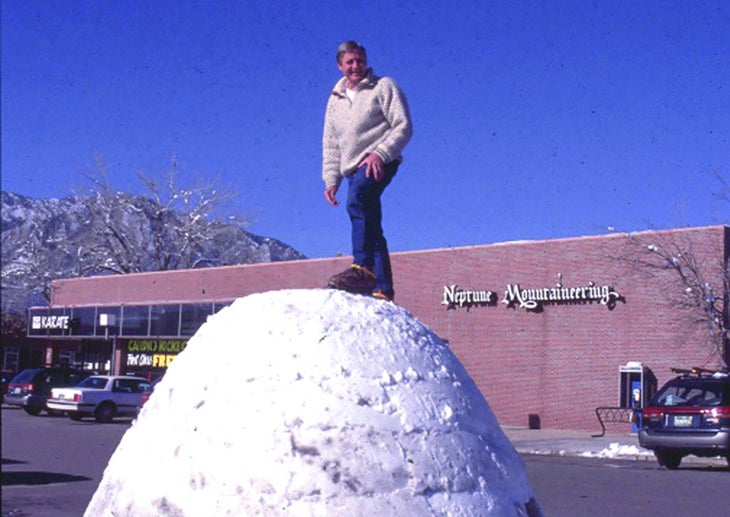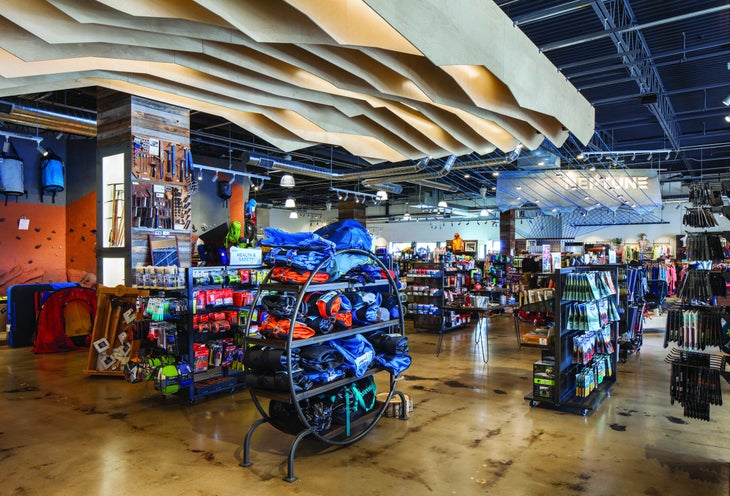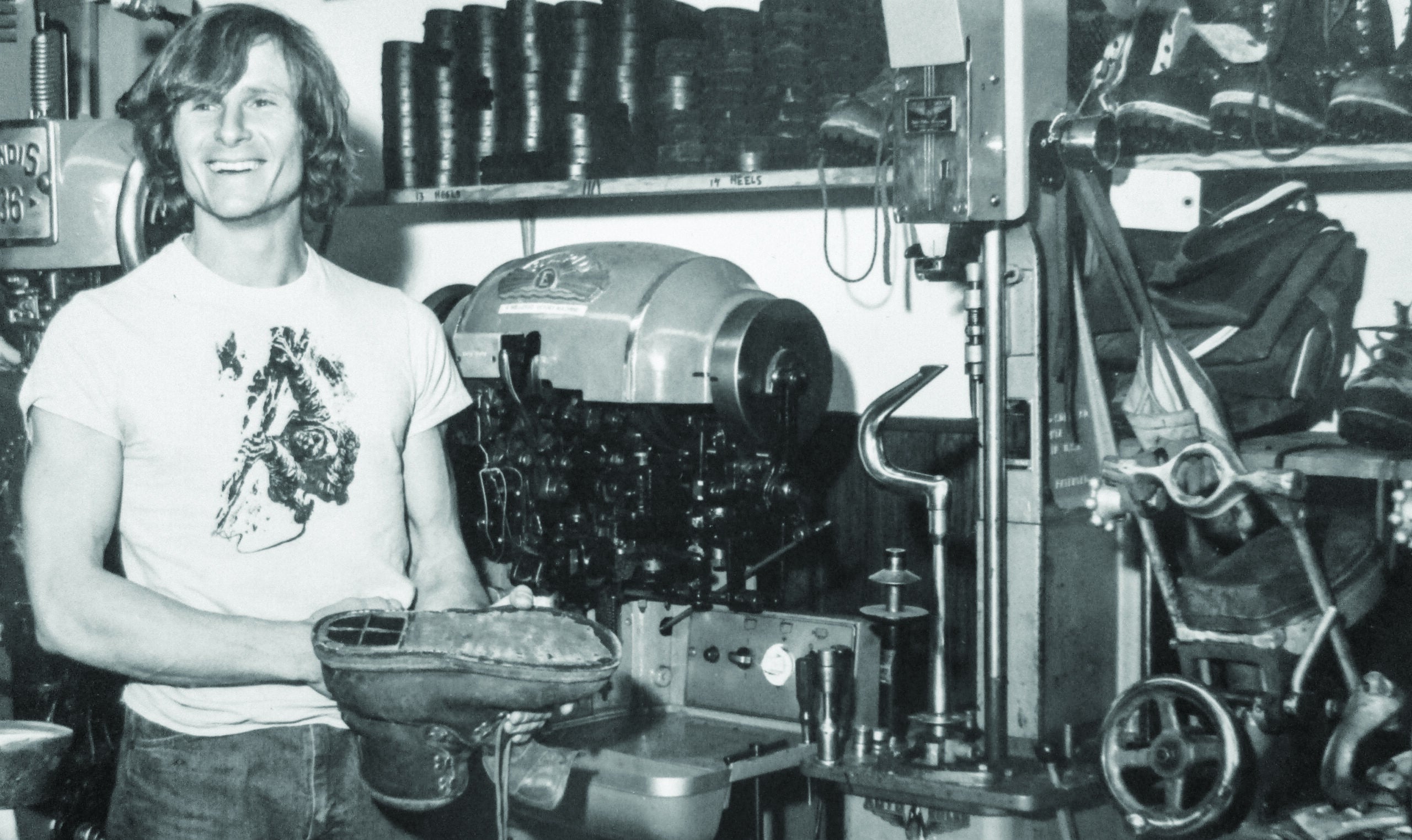To walk into Boulder, Colorado’s Neptune Mountaineering—one of the nation’s most storied outdoor gear shops—is to step simultaneously into the past and the future. Founded in 1973 by accomplished climber Gary Neptune, the store is a monument to mountaineering, with a vast collection of historic artifacts on display beside shelves of new gear. It’s a museum, a state-of-the-art retail space, and a community gathering hub all in one.
It’s also lucky to be around. Like many retailers, Neptune Mountaineering has struggled with profit margins and the bottom line over the years. It dodged a few close calls, changing hands and even surviving bankruptcy, but somehow, the store has managed to do more than hang on. It’s become an icon in both the community and the outdoor industry at large.
In September 2021, the business traded hands for the fourth time in its five-decade history. With a new chapter beginning for Neptune, there’s no better time to look back at the wild ride the shop has navigated to get where it is today.
A Wing, a Prayer, and a Barefooted Businessman
The first thing anyone needs to know about Gary Neptune is that back when he founded his shop, he preferred to be barefoot as much as possible. In his younger years, the now 74-year-old mountaineer was the kind of guy who challenged himself by using minimal equipment on his climbing adventures—or none at all. Neptune’s climbing résumé, by any measure, is stacked. He’s stood on the summits of Everest, Makalu, and Gasherbrum II, as well as countless other peaks in the Himalaya, Andes, and the American West.
This is important to understand because it tells you something about the early character of Neptune Mountaineering. Initially, the retailer was nothing more than a small boot- and climbing shoe- repair operation—more a place for Neptune and his friends to tinker than anything else. The shop’s main clientele consisted of other elite climbers in the area.
“I started the shop because there was another guy in town who repaired boots and sold a little climbing gear,” Neptune said. “But he was incredibly slow. It would pretty much take him all summer to fix your boots. A friend of mine convinced me that if we could buy some machinery, it would be a nice little niche [for us]. I liked handyman things, so I did it.”
The whole store, including the machinery Neptune needed to get started, cost about $14,000, he said. For years, the shop didn’t even have a cash register, and saw little return on Neptune’s initial investment. “We squeaked through for a number of years with a gross curve that was so flat you couldn’t tell if it was up or down,” he said.
Neptune discovered the hard way that growing a business for mountaineers meant giving up some of that mountaineering himself. One saving grace: the store’s location on the Front Range meant that he could at least climb locally on a daily basis. “That was why I located the store in Boulder and didn’t move away,” he said.
Neptune Mountaineering Hits Its Stride
After a full decade of barely making it, things finally started to pick up around 1983. This happened largely because, by then, the store had made a name for itself in the community. Talk to any climber who lived in Boulder during that time, and you’ll likely hear a Neptune Mountaineering story.
Part of that name-making involved inviting climbers and adventurers to the store to expound on their lives, work, and travels—a common practice now, but groundbreaking for a retail shop half a century ago. The events were a huge hit with customers. “Gary was always thinking about the bigger picture of the community rather than filling the cash register,” said Rick Hatfield, a ranger at Boulder Open Space and Mountain Parks, who often gave talks at the shop about nesting raptors and how the climbing community could help protect them. “In working with Gary, we all realized the value in collaborative efforts. Neptune has always been more than just a store.”
It was during this time that Neptune also started building out his collection of climbing and mountaineering artifacts, an effort that would eventually become the store’s renowned Neptune Museum.

Like so much else at the shop, the museum was a community effort. Though Neptune collected many of the pieces himself—including, famously, the disembodied, frostbitten toe of his friend and fellow climber Malcolm Daly—many items were donated from fans in Boulder and others around the world. (Today, you can trace the evolution of outdoor adventure equipment as you walk through the 17,000-square- foot store. Although Neptune eventually sold the shop in 2013, he never let go of the museum, which he still owns and curates.) The museum helped the store become a true destination for adventurers embedded in Boulder’s outdoor community. Even if a customer was just stopping to drop off skis for a tune-up, it was easy to linger, wandering around and marveling at the artifacts.
Neptune watched other stores in the area come and go over these years. Specialty shops that couldn’t harness Neptune’s magic cropped up here and there, lasted for a while, and then closed down. REI and other national outlets came to town as well. Through it all, Neptune kept a calm head and stuck to what he knew—offering expert advice and goods for serious mountaineers, and building community.
“I’m not afraid of competition,” Neptune said. “I like competition as long as people are trying to be better in their own way. What I really don’t like is the race for the bottom—cheaper, cheaper, cheaper. That’s not good for anyone.”
Disaster Comes Knocking
Once Neptune hit its stride, there was little competitors could do to diminish its power in the Boulder community. The store moved several times, eventually landing at its current home—an expansive building tucked into a strip mall on the south side of town—in 1993. The space expanded with each move, as did the product mix. What once had been a shop for only the most serious mountaineers became more welcoming of newcomers and more accessible to first-time outdoorspeople.
Neptune’s career fell into place, and after 40 years of running the show, he found himself ready to retire. In 2013, Neptune sold the business to Backwoods Retail, a Texas-based operation that, at the time, ran 10 specialty shops. Everything seemed in order; Neptune felt good about the future of his store and legacy.
But all was not peaceful and prosperous for long. According to Neptune, soon after the sale to Backwoods, communication became nearly impossible with the new owners.
Sales dropped off. The community feel of the store began to evaporate. Just a few years after the sale, Neptune Mountaineering was in serious trouble. By 2016, Backwoods owed nearly $70,000 in back rent on the store’s lease and far more to suppliers. The business filed for Chapter 11 bankruptcy reorganization. Many in the community thought their beloved shop was about to disappear forever.
Back from the Brink
If it weren’t for Shelley and Andrew Dunbar, the business would almost certainly be nothing more than a memory today.
The Dunbars, Boulder locals who had made a name (and a formidable living) for themselves in the outdoor industry by distributing Australia-based Sea to Summit’s products in the U.S., were longtime patrons of Neptune Mountaineering. Unwilling to see their community shop die, they swooped in and bought the business out of bankruptcy in 2017. They invested more than $1 million to renovate the space, opening it up, adding lots of light, and installing cool features like a climbing wall.
The shop needed a Hail Mary to save it. No idea was too bold. “Our personal motto was that you need to be a fearless retailer,” Shelley said. “That means you can’t be afraid to try new things. But it’s hard. Most retailers tend to take the safe path.”
The Dunbars were willing to take the kinds of risks that paid off. “[Customers] want to see evolution,” Shelley said. “They need to get excited about things and discover things. We fell on our faces a couple of times betting on products that didn’t sell, but people came back to us because things were different. It’s not like you have to try ideas that go against your brand and your ethos. But taking a few chances is good.”

One of the most important changes the Dunbars made was to the product mix. “We launched what we called the Neptune Lab,” Shelley said. “We found brands and products that were crowdfunded, mainly products that had been funded by Kickstarter. The reason that people use something like Kickstarter is because they can’t get into a retailer; they can’t get exposure.” The Dunbars were ready to take a chance on exactly those products. Some flopped, but some absolutely killed. “One example of a new category we tried was packrafting,” Shelley said. “We brought in a line of packrafts called Alpacka—a small Colorado company—and they were wildly successful.” The new products helped convince the Boulder community that Neptune Mountaineering was once again a place of forward-thinking expertise.
The Dunbars understood instinctively what Backwoods hadn’t: that Neptune couldn’t survive without the deep community feel that had characterized its earliest days. That understanding led to the launch of Neptune’s café, which provided a place for locals to gather and get reacquainted with the store they thought they’d lost.
Within a few years, Neptune Mountaineering had been rescued from the brink. “It was a lot of fun bringing Neptune back,” Shelley said. “We’re very proud of what we were able to do.”
The Story of Neptune Mountaineering Continues
The Dunbars will be the first to tell you that they never intended to run Neptune forever. Theirs was a rescue mission; the next chapter of leadership always belonged to someone else.
It took them a while to discover exactly who that person would be. In September 2021, after more than a year of entertaining offers, the Dunbars sold the business to Maile Spung and her father, Bob Wade, owners of another legacy retailer, Ute Mountaineer in Aspen.
Like the Dunbars, Spung and Wade are a family with deep ties to outdoor retail. Wade founded Ute Mountaineer in 1977, just four years after the launch of Neptune. The two shops grew up alongside each other, and in some ways it’s fitting they’re now playing for the same team.
“Neptune has always had this sentimental place in people’s hearts in the outdoor industry,” Spung said. “There’s a feeling of responsibility to the Boulder community to make sure the shop they know and love continues to run the way they want it to.”
For this reason, Spung is determined to maintain close ties to Gary Neptune, the business’s true beating heart. “Gary’s excited to bring some new pieces to the museum—a dogsled, some old backpacks and Nordic boots—and we want to focus on helping him keep that history alive,” Spung said.
As for Neptune himself, he feels this changing of the guard is a step in the right direction. “Maile grew up doing this, and for some reason she enjoys it,” he said, laughing. “She knows how to do pretty much everything. I think she’s a little bit like me in that she doesn’t have her nose in a computer all the time, although I’m sure she’s better at all of that stuff than I am.”
There’s a twinkle in his eye as he muses on the continuation of his life’s work. Any true adventurer would recognize it: the thrill, the challenge, the promise of unexplored territory. Neptune Mountaineering has wended its way through some tricky and beautiful terrain over the last 50 years, but the journey seems far from over. The best may be yet to come.


